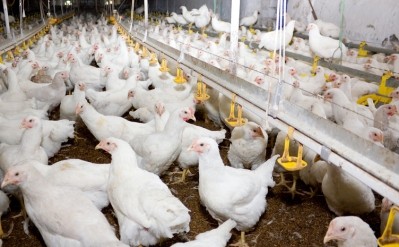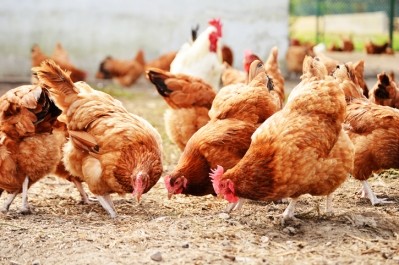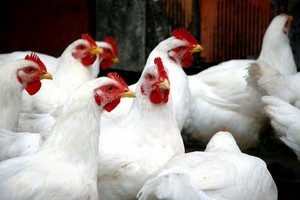Trial analytical method may allow for ‘greener’ feed analysis

A team of researchers from the Federal University of Pelotas in Brazil examined a new and environmentally responsible way to establish the levels of phosphorus (P) and sulfur (S) in animal feed and compared the results to feeds examined through the conventional process. The team published its work in the journal Food Chemistry.
“The microwave-assisted digestion using diluted nitric acid under oxygen pressure was evaluated for subsequent determination of P and S by IC [ion chromatography] in animal feed,” they said. “Some parameters such as digestion efficiency and the compatibility between the digests and IC technique were investigated.”
The researchers found that using a pressurized, microwave system to digest animal feed they were able to produce analytical results for P and S that were similar to those generated through the traditional method of analysis. It also reduced the steps involved and limited waste production.
“The microwave-assisted digestion under oxygen pressure allows the use of diluted acids and could be considered a great alternative to digestion of animal feed for subsequent determination of P and S by IC,” the researchers said. “The possibility of using diluted solutions without compromising the oxidation efficiency of organic matter enables obtaining a final solution compatible with IC analysis as well as minimizes the waste generation.”
Why develop new analytical methods?
As an increasing number of animals are produced annually, there has been a growth in animal feed supplementation, said the researchers. Feeds need to provide the necessary concentration of nutrients as feed composition can influence animal health, productivity and human health.
Phosphorus and sulfur are considered essential nutrients in animal diets, however, excessive amounts in animal feed can generate health problems, limit amino acid digestibility, increase blood pressure and reduce mineral availability, they said.
To determine feed safety, concentrations for P and S used in feed have been established, they said. Official methods to analyze a feed’s nutritional content for quality control also have been set.
Of the methods specified to check for P levels, one uses spectrophotometric determination and prepares samples with “dry ashing,” they said. However, the process had several drawbacks including a long list of steps, use of concentrated chemicals, low sample throughput and high limits of detection (LODs).
Similarly, AOAC International suggests that gravimetric methods be used for S determination in multiple organic matrices where S is examined as barium sulfate (BaSO4), however, there is not an official method for S examination in animal feed, said the researchers. “Thus, it is of paramount importance to propose appropriate analytical methods for quality control of P and S in animal feed,” they added.
Currently, the easiest way to prepare samples for analysis uses a representative solution, they said.
“Microwave-assisted digestion in closed vessels has been considered the state-of-the-art to convert the solid sample in an aqueous solution,” they said. “However, concentrated acids are usually required to assure the efficiency of the process, and the high residual acidity in the digests may not be supported by some determination techniques.”
Additionally, concentrated acids can be environmentally hazardous and expensive to mitigate, they said. To address these concerns, microwave-assisted digestion in an oxygen-rich atmosphere has been used in sample preparation.
Ion chromatography is an established process for determining P and S in samples, said the researchers. “Ion chromatography presents sequential multi-elemental determination capability, a stable separation system, good selectivity and speed of analysis, allowing P and S indirectly determination as phosphate and sulfate,” they added.
However, high concentration of dissolved organic carbon, along with remaining acidity and nitrate level can be problematic and make analysis by IC impossible, they said. An improved sample preparation method is needed to use this technique.
One potential advantage of the trial method is that incorporating oxygen pressurization may allow for the use of diluted acid in sample digestion, they said.
In the process, weak nitric acid could be regenerated as the organic matter oxidizes, they said. This interaction means the microwave-assisted digestion method using a weak acid and oxygen pressure could provide an alternative method for sample preparation during the process of establishing amounts of P and S in feed.
Methods and materials
Feed samples were ground, dried and digested using a microwave oven, the researchers said. P and S levels were sought as phosphate and sulfate using an IC.
Animal feed samples, from feeds manufactured in Brazil, were taken from diets for bulls, calves, horses, rabbits, chicken and fish, they said.
Digestion efficiency was evaluated and an axial view configuration was used to determine the dissolved organic carbon in the digests, they said.
A conventional microwave-assisted digestion process was evaluated using 500mg of animal feed samples, they said. The process was then repeated using a system pressurized to 20 bar of oxygen pressure.
“After the conclusion of microwave irradiation program, the pressure of each vessel was carefully released, and the digests were transferred to volumetric vessels and diluted to 25 mL with water for subsequent P and S determination by IC,” said the researchers. “The digestion efficiency of both methods was evaluated by determination of dissolved organic carbon and residual acidity in digests, which were determined by ICP-OES [inductively coupled plasma optical emission spectrometry] and acid-base titration, respectively.”
The digestion method accuracy was evaluated using recovery tests and a reference standard solution, they said. The recommended method of determining P also was performed for result comparisons.
Results
Initially, the microwave-assisted digestion method, both with or without oxygen pressure, and using different concentrations of chemicals was checked to find the lowest concentration of HNO3 (nitric acid) that would be able to digest 500mg of animal feed, said the researchers.
Similar results were found using concentrations of 7 or 14.4 mol L-1 HNO3 in both the pressurized and non-pressurized digestion process, they said. However, there were differences when lower concentrations were used.
Solutions of 2 mol L-1 HNO3 were needed to dissolve the feed when oxygen pressure was also used, they said. The results were similar to what was found when more concentrated solutions were used.
“It is possible to reduce the acid concentration up to 3.5 and 7 times when compared to the performance of conventional microwave-assisted digestion process, without decreasing the digestion efficiency,” they said. “In addition, it is possible to minimize the dilution of the sample prior to analysis as well as some interferences during the determination step. As a result, lower LODs and more reliable values may be obtained.”
The trial method was applied to all feed samples and there was an indirect analysis of P and S using IC, said the researchers. Feed samples also were analyzed using the traditional method for P determination.
There were no significant differences for the concentrations of P found in the animal feeds using the two different methods, they aid.
“Using the proposed method, it was possible to digest efficiently 500 mg of animal feed using only diluted acid (2 mol L−1 HNO3),” they said. “When compared to conventional microwave-assisted digestion method using 7 or 14.4 mol L−1 HNO3, the proposed method allows a reduction of the use of nitric acid (at 3.5–7 times) with the same digestion efficiency.”
Source: Food Chemistry
Title: A novel and eco-friendly analytical method for phosphorus and sulfur determination in animal feed
Authors: Diogo Novo, Rodrigo Pereira, Vanize Costa, Carla Hartwig, Marcia Mesko
DOI: doi.org/10.1016/j.foodchem.2017.11.036














